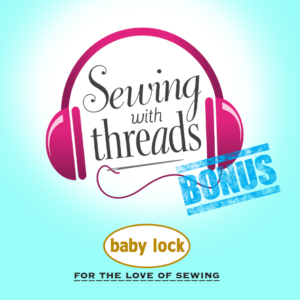
In the Sewing with Threads Episode 19 video podcast, Threads Digital Ambassador and vintage pattern aficionado Peter Lappin shares his latest vintage pattern creations, discusses his camp shirt class, and delves into garment plackets and interfacings.
Camp shirts are big
Peter, who was recovering from some minor scrapes he sustained in a running mishap, says he’s pleased with the resurgence of the versatile camp-collar shirt. Also called the bowling shirt, aloha shirt, and Hawaiian shirt, it is more precisely referred to as a convertible-collar shirt. Peter is teaching “Sew the Camp Shirt” class, available on Bluprint.
Popover shirts
Among Peter’s other recent creations is a popover shirt, a men’s cotton shirt featuring a half-placket. This classic style, which you “pop over your head” to wear, was popular in the late 1950s. The dressy-casual look is still widely available. He made the shirt from a vintage McCall’s pattern, and color-blocked it using three fabrics from Loom & Stars.
Sewing the shirt’s short center-front placket is similar to sewing a sleeve placket, Peter says. He walks through how to sew a sleeve placket in “A Guide to Sewing Professional Sleeve Plackets,” available to Threads Insider members. For information on how to fix a sleeve placket mistake, see the upcoming “Sewing Saves: Fix a reversed placket,” Threads #205 (Oct./Nov. 2019).
Peter also explains his technique for finishing the hem on his fine cotton popover shirt. Go to “How to Sew a Narrow Hem on Lightweight Fabrics” for a similar method.
Among the differences between vintage and contemporary commercial patterns is seam allowances. Peter says many of his older patterns, such as the Advance men’s pajama pattern he recently used, require 1/2-inch-wide seam allowances.
Peter shares even more of his creations and his sewing adventures on his blog, Male Pattern Boldness.
Interfacing challenges
Though a sewing veteran, Peter admits he struggles with choosing the right interfacing from the wide selection on the market today. He also discussed one editor’s problem with fusing interfacing to a fabric.
For a breakdown of interfacing types, see this guide. and watch a Threads video for tips on applying fusible interfacing.
Fashion Sewing Supply is one reputable source Peter relies on for interfacing.
This episode is sponsored by Baby Lock.
Wherever your embroidery journey takes you, Baby Lock’s embroidery machines are here to make it easy – every step of the way! Baby Lock’s new machines are easier than ever to use and incorporate some of the latest embroidery technology available. Select models include the all-new IQ Intuition™ Positioning App, which enables you to take a photo of your fabric in a special hoop and transfer it wirelessly to the machine. You can position your design exactly where you want it, how you want it – every time. It’s embroidery made easy! Visit BabyLock.com to learn more.

We have created a podcast survey to help guide our content. Please take a moment to answer a few questions.








































My friends and I like to make camp shirts using quilter cottons. And, we mix an match the prints for collars and sleeves, etc.
Genie,